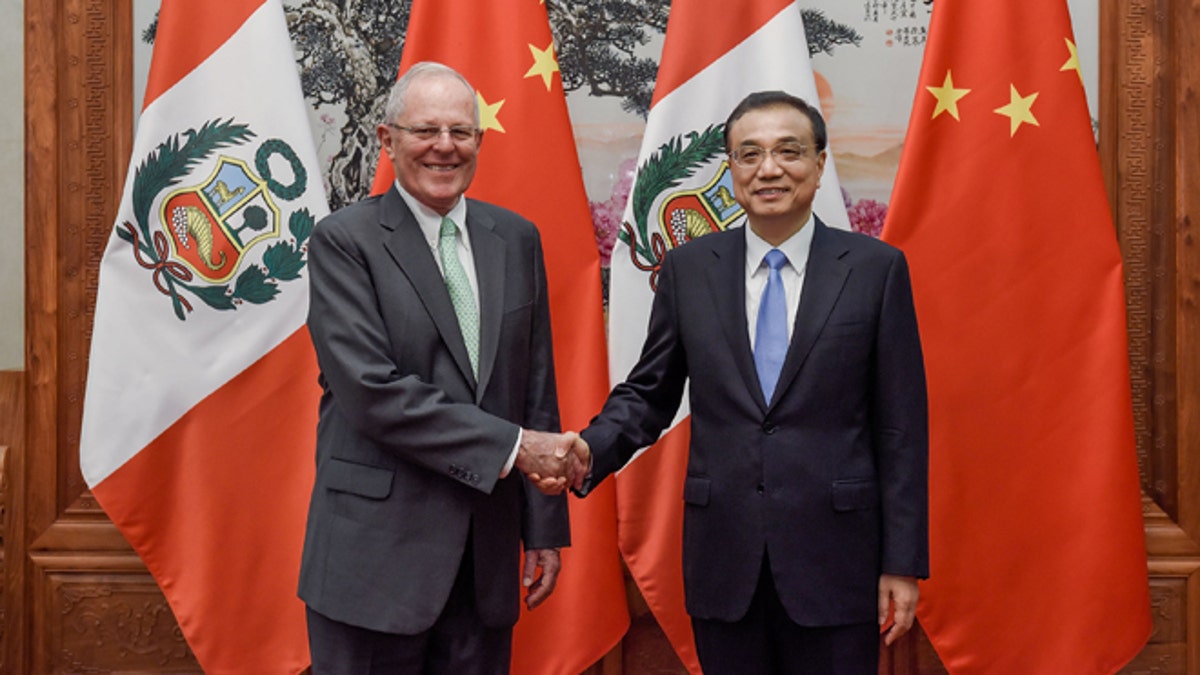
Chinese Premier Li Keqiang and Peruvian President Pedro Pablo Kuczynski on September 14, 2016 in Beijing, China. (2016 Getty Images)
On November 18th, Barack Obama visits Latin America as president for the last time to attend the Asia Pacific Economic Cooperation (APEC) Leaders’ Summit hosted in Lima, Peru.
This is the second time this meeting will take place in Peru, a country hosting several high-level international conferences in recent years including the World Bank’s Annual Meeting of the Board of Governors in 2015 and the United Nations Climate Change Conference (COP20) the year prior.
While certainly an honor and privilege for Peru, these high-profile gatherings also heighten security concerns around Islamic terrorism in a country and region not accustomed to this kind of threat.
Going forward, with the help of the new Trump administration, Peru can become Latin America’s leader in the global fight against expanding Islamic terrorism, a vacancy that urgently needs to be filled in our region.
Peru is no stranger to terrorism, having been the victim of terrorist violence since 1980 when the Partido Comunista de Peru—Sendero Luminoso de Mariategui, more commonly known as the Shining Path, initiated a bloody war against the Peruvian state and people. Or in 1985, when the Túpac Amaru Revolutionary Movement (MRTA) began a comparable terrorist offensive. Threats from Islamist terrorist networks, however, are a more recent phenomenon.
Currently, an ongoing Peruvian trial could be the most important counterterrorism case preparing Latin America for the rising threats emanating from the global Jihad.
On October 28, 2014, just months before the United Nations COP20 meeting in Lima, a Lebanese national named Mohamed Ghaleb Hamdar was arrested and charged with potentially plotting a terrorist attack in Peru. Hamdar, a self-admitted member of Hezbollah, was apprehended with several hundred pictures of critical infrastructure and potential high-value targets on his iPad and cell phones. On further investigation, it was later discovered that he handled chemicals such as nitroglycerine often used in explosives. While his motivations and objectives are unclear, two years later, Hamdar is now the subject of a terrorism trial in Peru that could change the legal landscape in Latin America.
If convicted, Hamdar will be the first member of an Islamic terrorist organization imprisoned for plotting a terrorist attack in Latin America, although Islamic terrorists have been operating in the region for decades. This is an important legal precedent sending a strong signal to Jihadists around the world that Peru and Latin America are off limits.
History shows terrorist groups, particularly Jihadists, compensate for their lack of conventional strength with opportunistic timing and careful selection of targets. The presence of so many heads of state in Peru, including President Obama at the upcoming APEC meeting, presents a golden opportunity for Jihadists to act. This challenge is compounded by the region’s lack of legal framework for monitoring and punishing active terrorist agents. That is why the case of Mohamad Ghaleb Hamdar in Peru is so important and merits global attention.
Peru has plenty of experience in antiterrorism efforts, resulting from years of experience battling the Shining Path and MRTA. However, many of the counterterrorism officials who dealt with these terrorist groups in the 1980s and 1990s are now retired, and efforts to systematically institutionalize their expertise was undervalued by previous Peruvian governments.
For instance, the Peruvian National Intelligence Service, known as the DINI, has significantly deteriorated in recent years due to political scandals in the previous administration. The predictive analysis necessary to fight terrorist networks has been abandoned and the DINI has produced limited analytical products in the last two years. As a result, there has been a resurgence in Shining Path’s activity in illicit industries and drug trafficking, as well as an intensification in their involvement in social conflicts that have caught the previous and current government by surprise.
This past July, Pedro Pablo Kuczynski or PPK, was inaugurated as Peru’s new president. Months into PPK’s presidency, the DINI continues under the previous government’s leadership and without changes, the likely result will be more unpleasant surprises by nefarious elements operating within our borders. The legacy of the Bolivarian Alliance of the Americas (ALBA), an anti-American bloc created by the late Hugo Chávez and the Castro’s in Cuba, is present in Peru. ALBA-inspired social movements in Peru engage in propaganda and destabilization against the government, while Iran and Hezbollah, open allies of the ALBA, follow close behind.
For instance, a small Islamist group, known as Inkari-Islam, has been operating in the resource-rich region of Apurimac, in south-central Peru. In recent years, this group has seen members traveling repeatedly to Qom, Iran for training and indoctrination. While there is no known connection between this Islamist group in Apurimac and presumed terrorists in the country, such as Hamdar, it is clear that Iran and Hezbollah have invested at least some resources into establishing a political support base on Peruvian territory.
Political movements don’t equal terrorism, however, terrorist groups do need political cover in which to operate. In this sense, Peruvian authorities need help in understanding the nexus of political movements and terrorism coming from the Middle East.
President Kuzynski and President Obama will meet soon at the APEC summit to discuss bilateral issues. Part of this conversation should focus on increased counterterrorism cooperation. Going forward, with the help of the new Trump administration, Peru can become Latin America’s leader in the global fight against expanding Islamic terrorism, a vacancy that urgently needs to be filled in our region.
